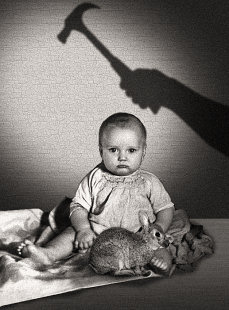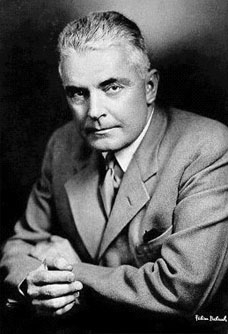
In the early decades of the twentieth century the discipline of psychology was still in its infancy, but beginning to make significant headway. Pioneering researchers were enthusiastically unraveling the human mind, and some were willing to go to alarming lengths to satisfy their curiosity.
One such trailblazer was a behaviorist named John B. Watson. In 1919, his curiosity was aroused after observing a child who showed an irrational fear of dogs. Watson supposed that a shiny new human would not possess an inborn fear of domesticated animals, but if “one animal succeeds in arousing fear, any moving furry animal thereafter may arouse it.” In order to satiate his scientific appetite, he undertook a series of experiments at Johns Hopkins University to determine whether an infant could indeed be conditioned to fear cute-and-cuddly animals by associating them with scary stimuli. A couple decades earlier Pavlov’s notorious dogs had been conditioned to salivate at the sound of a bell; Watson hoped to expand upon the concept.
In 1920 Watson secured access to a “healthy, stolid, and unemotional” nine-month-old infant named Albert B., the son of a wet nurse who worked in the hospital. He was assisted by Rosalie Rayner, a graduate student at the university. The researchers’ first order of business was to establish a psychological baseline. They tried exposing the infant to a white rat, a rabbit, a dog, and a monkey, and Albert reached for each animal with cheerful curiosity. The researchers brought him items such as masks and clumps of cotton, and he manipulated the objects with interest. They placed a long steel rod behind Albert’s head and struck the metal sharply with a claw hammer, and he flinched with evident distress. The infant’s baseline reactions to these stimuli were duly noted, and two months later the peculiar series of “joint stimulation” experiments was underway. Excerpts from Dr. Watson’s notes outline its progression:
Age: 11 months, 3 days
- White rat suddenly taken from the basket and presented to Albert. Just as his hand touched the animal the bar was struck immediately behind his head. The infant jumped violently and fell forward, burying his face in the mattress.
- Just as the right hand touched the rat the bar was again struck. Again the infant jumped violently, fell forward and began to whimper.
- Rat presented suddenly without sound. When the rat nosed the infant’s left hand, the hand was immediately withdrawn. It is thus seen that the two joint stimulations given the previous week were not without effect.
- Joint stimulation. Fell over immediately to right side and began to whimper.
- Rat alone. The instant the rat was shown the baby began to cry. Almost instantly he turned sharply to the left, fell over on left side, raised himself on all fours and began to crawl away so rapidly that he was caught with difficulty before reaching the edge of the table.
Age: 11 months, 15 days
- Rat alone. Whimpered immediately, withdrew right hand and turned head and trunk away.
- Rabbit alone. Negative responses began at once. He leaned as far away from the animal as possible, whimpered, then burst into tears. When the rabbit was placed in contact with him he buried his face in the mattress, then got up on all fours and crawled away.
- Fur coat (seal). Withdrew immediately to the left side and began to fret. Coat put close to him on the left side, he turned immediately, began to cry and tried to crawl away on all fours.
- [A lab assistant] brought the Santa Claus mask and presented it to Albert. He was again pronouncedly negative.
- Rat alone. Withdrawal of the whole body, bending over to left side, no crying. Fixation and following with eyes. It was thought best to freshen up the reaction by another joint stimulation.
- Just as the rat was placed on his hand the rod was struck. Reaction violent.
- Rabbit alone. Leaned over to left side as far as possible. Began to whimper.
- When the rabbit was left on Albert’s knees for a long time he began tentatively to reach out and manipulate its fur with forefingers. While doing this the steel rod was struck. A violent fear reaction resulted.
- Rabbit alone. Started immediately to whimper, holding hands far up, but did not cry.
Watson next sought to determine whether these acquired fears had any substantial staying power. The researchers granted the infant a one month reprieve, after which they once again confronted Albert with his fuzzy phobias:
Age: 12 months, 21 days
- Santa Claus mask. Withdrawal, gurgling, then slapped at it without touching. When his hand was forced to touch it, he whimpered and cried. He finally cried at the mere visual stimulus of the mask.
- Fur coat. Wrinkled his nose and withdrew both hands, drew back his whole body and began to whimper as the coat was put nearer. In moving his body to one side his hand accidentally touched the coat. He began to cry at once, nodding his head in a very peculiar manner.
- The rat. He allowed the rat to crawl towards him without withdrawing. The rat was then allowed to crawl against his chest. He first began to fret and then covered his eyes with both hands.
- The rabbit. After a few seconds he puckered up his face, began to nod his head and to look intently at the experimenter. He reached out tentatively with his left hand and touched the animal, shuddered and withdrew the whole body. The experimenter then took hold of his left hand and laid it on the rabbit’s back. Albert immediately withdrew his hand and began to suck his thumb. Again the rabbit was laid in his lap. He began to cry, covering his face with both hands.
 John B. Watson
John B. Watson Without a doubt, the thirty day hiatus was insufficient to expunge the artificially-induced fear. One last scientific question remained: could these conditioned emotional responses be removed through laboratory methods? Watson had originally intended to end his experiment by “re-conditioning” the infant to neutralize the fear response, but he ultimately opted to drop that portion of the experiment due to a lack of time. When he published the results of his study, however, he suggested that the best re-conditioning method would have been to replace the traumatizing metallic CLANG! with a positive stimulus such as A) physical stimulation of “first the lips, then the nipples and as a final resort the sex organs”; B) candy or food; or C) constructive activities.
The psychological community received Watson’s results with rapt fascination. Several months later, in spite of his new-found popularity, the officials at Johns Hopkins asked Watson to resign from the university. But the request had nothing to do with the questionable ethics of his baby-scaring experiments; he was dismissed due to unauthorized “experimentation” with a lovely young graduate student. Watson’s wife discovered evidence that he and his assistant Rosalie Rayner had participated in unabashed physical stimulation of one another’s sex organs, and consequently Watson lost his career and his marriage amidst a flurry of publicity.
By modern standards, Watson’s infant-phobia experiment was grossly unethical for numerous obvious reasons. The research was undertaken during the rough-and-tumble adolescence of psychology, a time when the subjects’ well-being was seldom considered equal to the scientific rewards. Moreover, the experiment itself was rife with procedural flaws which rendered the results ambiguous at best. For instance, the researchers only tested with one subject and one negative stimuli, and the tests tended to be improvised and slapdash. Although Watson himself conceded that the experiment was imperfect, he considered the results to be valuable to science. “These experiments would seem to show conclusively that directly conditioned emotional responses as well as those conditioned by transfer persist, although with a certain loss in the intensity of the reaction, for a longer period than one month,” he wrote in his infamous paper. “Our view is that they persist and modify personality throughout life.”
Today, the “Little Albert” experiment is the stuff of psychological legend. It has been thoroughly cited, scrutinized, expanded, and embellished since its publication in 1920. But as is true with many fundamentally flawed studies, the scientific community ultimately categorized the experiment as intriguing-yet-uninterpretable. Though Watson spent the rest of his career begging to differ, no firm conclusions can be drawn from his hard-earned data–except perhaps that one should avoid employing experimental psychologists as babysitters.
As for Albert, he and his mother slipped into obscurity immediately following the study, and were never publicly identified. No one knows what ultimately became of the tormented infant, nor whether his repulsion of cute-and-cuddly creatures haunted him into adulthood.
http://www.youtube.com/watch?v=KxKfpKQzow8

No comments:
Post a Comment